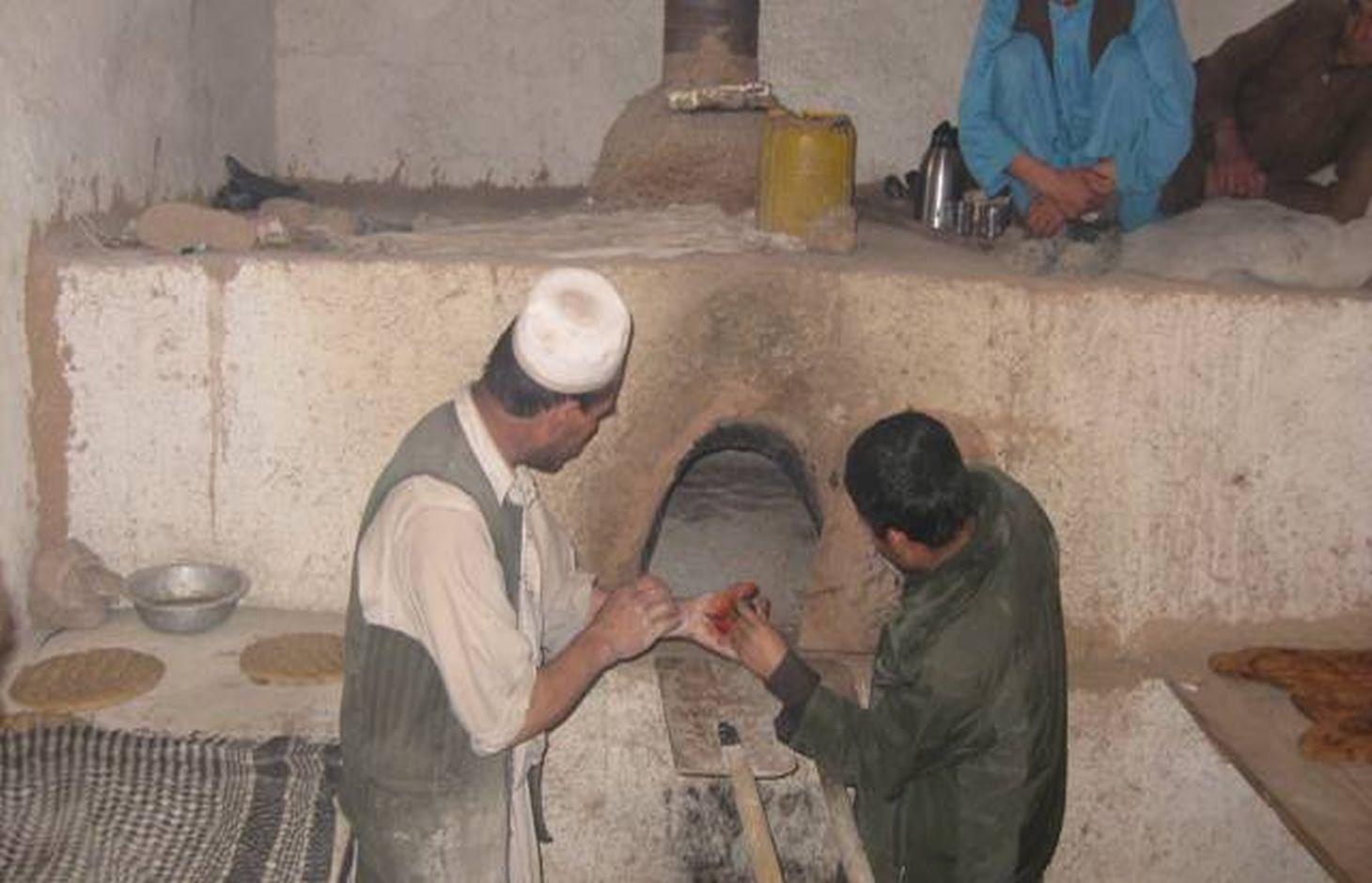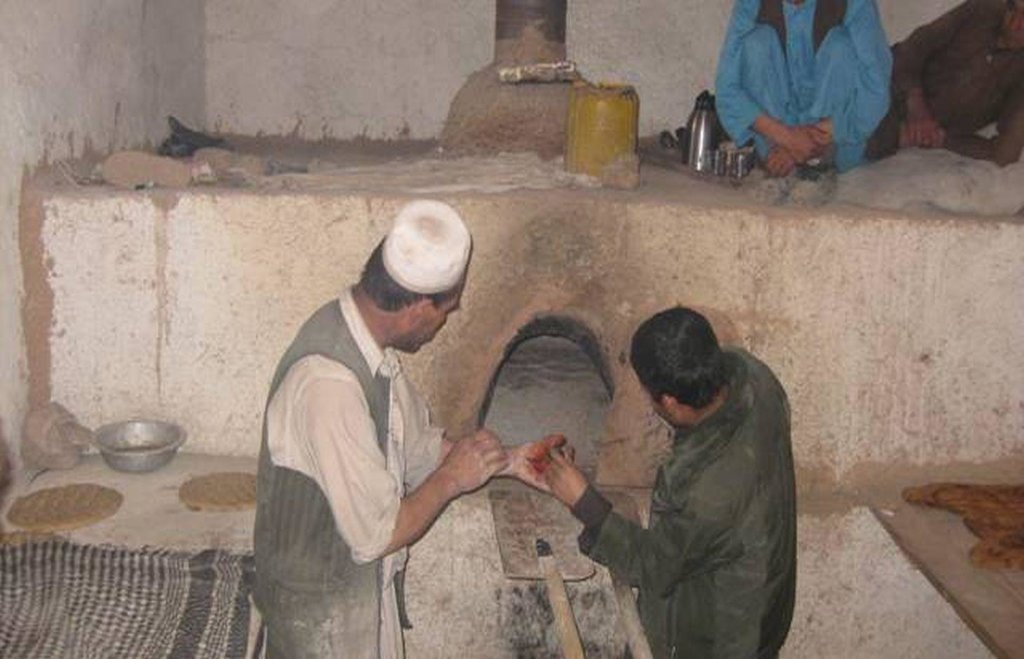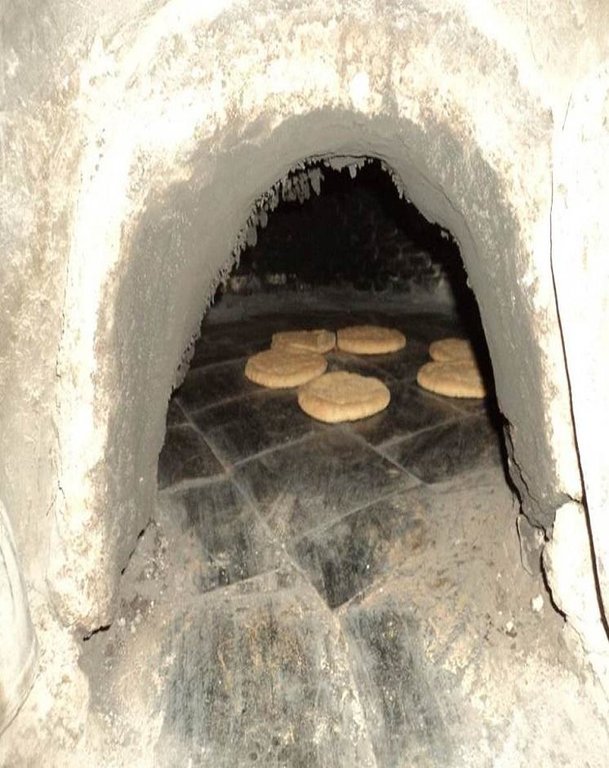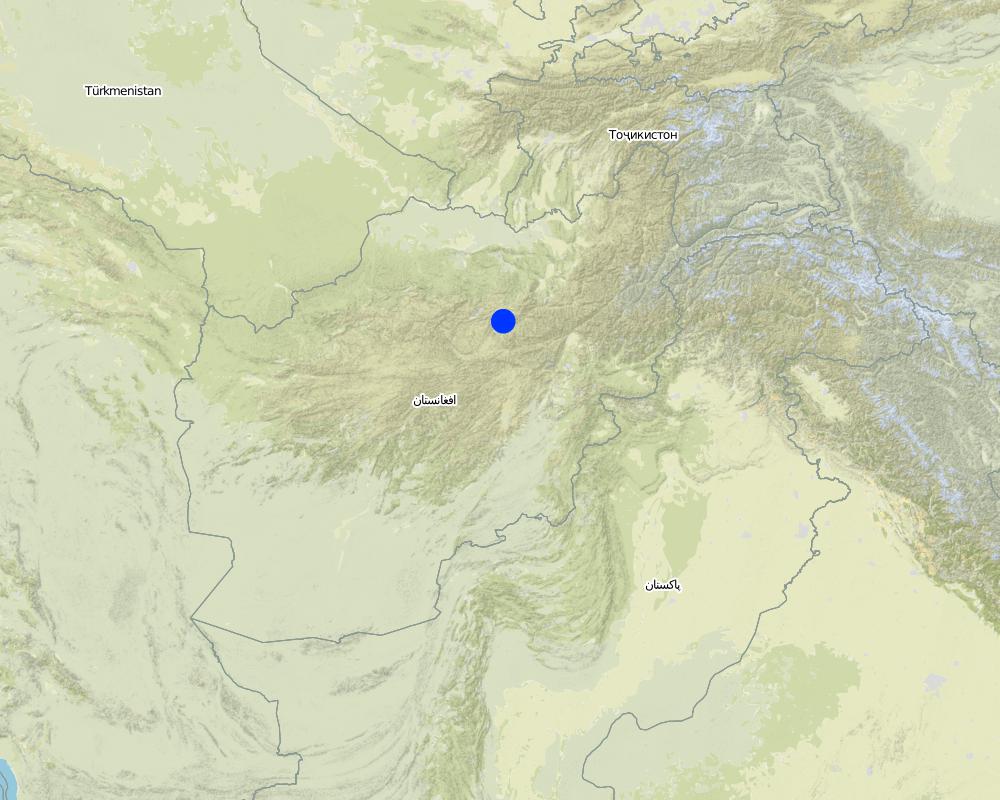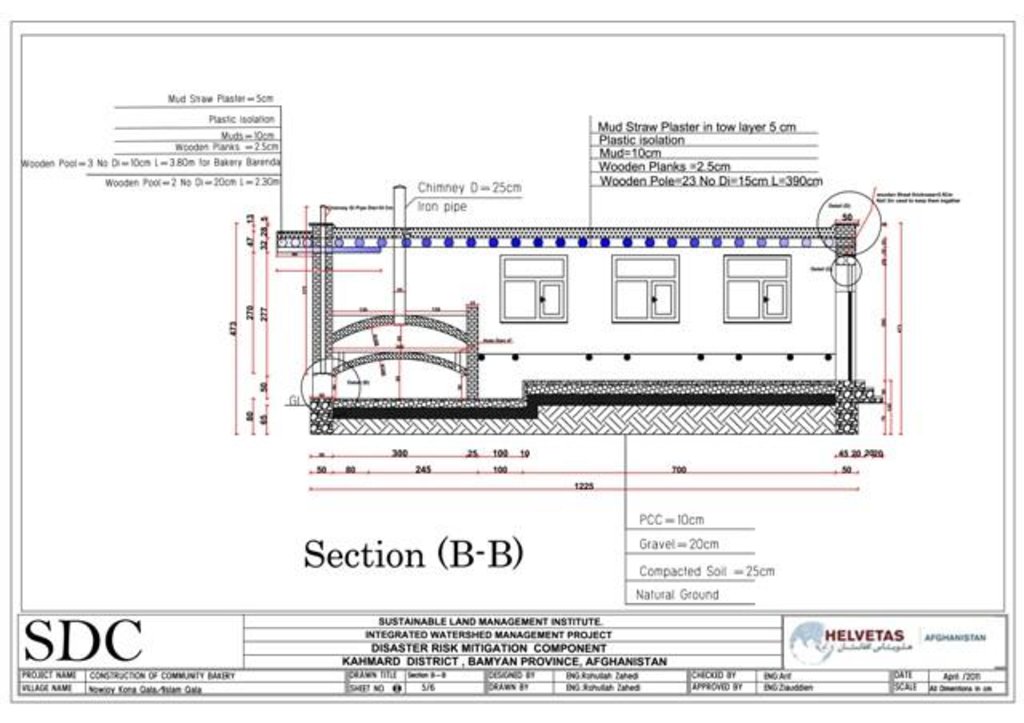Community bakery [Afeganistão]
- Criação:
- Atualização:
- Compilador/a: Aqila Haidery
- Editor: –
- Revisores: Deborah Niggli, Joana Eichenberger
Dash Nanboe (Dari)
technologies_1718 - Afeganistão
Veja as seções
Expandir tudo Recolher tudo1. Informação geral
1.2 Detalhes do contato das pessoas capacitadas e instituições envolvidas na avaliação e documentação da tecnologia
Especialista em GST:
Homayoun Ashraf
HELVETAS Swiss Intercooperation
Afeganistão
Especialista em GST:
Ahmad Ali Sediqi
HELVETAS Swiss Intercooperation
Afeganistão
Nome da(s) instituição(ões) que facilitou(ram) a documentação/ avaliação da Tecnologia (se relevante)
HELVETAS (Swiss Intercooperation)1.3 Condições em relação ao uso da informação documentada através de WOCAT
O compilador e a(s) pessoa(s) capacitada(s) aceitam as condições relativas ao uso de dados documentados através do WOCAT:
Sim
1.4 Declaração de sustentabilidade da tecnologia descrita
A tecnologia descrita aqui é problemática em relação a degradação da terra de forma que não pode ser declarada uma tecnologia de gestão sustentável de terra?
Não
2. Descrição da tecnologia de GST
2.1 Descrição curta da tecnologia
Definição da tecnologia:
A sustainable option for bread baking and reducing shrub consumption
2.2 Descrição detalhada da tecnologia
Descrição:
Thirty six community bakeries were constructed in Kahmard from 2009-2012 for reducing shrub consumption. Rural communities normally bake bread at home using tandoors made from clay and fired by shrubs, wood and coal. Bread baking is a demanding task. Men and boys climb mountains to collect shrubs, putting themselves at risk, and women spend 1-2 hours/day for preparing dough, firing the oven and baking bread. Shrub cutting causes upland degradation leading to flash floods in the valleys.
In Saighan, district adjoining Kahmard, a survey showed that one household uses 81 donkey load shrubs annually, and minimum 50 donkey loads are used for baking bread. Kahmard has a similar situation. To address this, HELVETAS Swiss Intercooperation is supporting an integrated watershed management in Kahmard since 2008 with support from the Swiss Re and Swiss Agency for Development and Cooperation (SDC). The approach comprises other technological and organisational measures where structural and vegetative are applied, combined with grazing and shrub cutting control. To complement re-greening efforts, energy efficient community bakeries were promoted.
Households using community bakeries reported a decrease in shrub consumption by 50-80%, which contributes to greener watersheds. The other benefits include more time for women, boys and girls for other preferred activities, like attending school, literacy classes, vocational trainings, embroidery, etc. Families also save money (minimum US$ 10/month) as they have to purchase less shrubs for baking purpose. In Kahmard, one donkey load shrub costs about US$ 6. Bakers, assistant bakers, masons and workers are employed and bakeries serve as a place for social networking. By contributing to greener watersheds, the bakeries help to reduce flash flood risks. In recent months, running the bakeries has become a challenge as the coal mines in Kahmard have been contracted to a Chinese firm. As a consequence, people are not getting coal easily. Due to coal shortages, several bakeries have stopped functioning. People are looking towards the government authorities to solve this issue as soon as possible. Many households have gone back to shrub cutting and a community assets with proven benefits for the people but environment remains underutilized.
The participating community development councils or CDCs allocate land for bakery. One bakery costs about US$ 4640, with 25% community contribution during construction. It takes about 5 weeks for constructing one bakery if there are no obstacles. About US$ 7300/year is spent on operation and maintenance by the people. One baker and 1-2 assistants are employed for daily bakery operations. The dash or oven is prepared from a mixture of clay and sheep hair and fired by coal. About 1-3 bags are required per day. If mosaic tiles are used, about 1 bag per day is used for heating. The factors influencing the success of community bakeries include access to coal, good quality and low price of coal, on time payment and proper management of bakery funds. The clients bring dough from home and pay about US$ 0.042 (2 Afghani) per bread to the baker or about US$ 6.6/month.
Community bakeries were constructed in the Kahmard district in the valley bottoms where the people reside. The land for community bakeries normally belongs to the community, but where suitable common land is not available, individuals have also donated their private lands for the common cause.
Community bakeries are located at an altitude of about 1700-1800 m above mean sea level. The district receives up to 400 mm rainfall in a good year. In the valley bottom, there are crop growing seasons, the main is from March to July. The land users rely mainly on agriculture for their livelihoods as employment opportunities in the district are very few. Kahmard district has a population density of about 30 person/sq. km. About 50% of the rural population in Kahmard falls under poor category, 40% are medium rich and 10% rich.
2.3 Fotos da tecnologia
2.5 País/região/locais onde a tecnologia foi aplicada e que estão cobertos nesta avaliação
País:
Afeganistão
Região/Estado/Província:
Bamyan Province
Especificação adicional de localização:
Kahmard district
Especifique a difusão da tecnologia:
- Uniformemente difundida numa área
Se a área precisa não for conhecida, indicar a área aproximada coberta:
- < 0,1 km2 (10 ha)
Comentários:
Each bakery has an area of about 58 sq. m, and 25 bakeries have been constructed so far in Kahmard district with HELVETAS Swiss Intercooperation support and financial contributions from the Swiss Agency for Development and Cooperation (SDC).
Map
×2.6 Data da implementação
Caso o ano exato seja desconhecido, indique a data aproximada:
- menos de 10 anos atrás (recentemente)
2.7 Introdução da tecnologia
Especifique como a tecnologia foi introduzida:
- através de projetos/intervenções externas
Comentários (tipos de projeto, etc.):
The first community bakery in Kahmard district was constructed in 2009 with HELVETAS Swiss Intercooperation support. Since then, 25 bakeries have been constructed as a complementary watershed management technology.
3. Classificação da tecnologia de GST
3.2 Tipo(s) atualizado(s) de uso da terra onde a tecnologia foi aplicada

Assentamentos, infraestrutura
- Community bakeries

Terra improdutiva
Especifique:
Wastelands, deserts, glaciers, swamps, recreation areas, etc before Technology, settlements, infrastructure networks afterwards.
Comentários:
Major land use problems (compiler’s opinion): Severe flash floods due to degradation of upland watersheds as a result of overgrazing, shrub uprooting, ploughing and recurring droughts. There is a lack of organizational capacities for sustainable management of land and water resources.
Major land use problems (land users’ perception): Severe flash floods due to watershed degradation resulting in destruction of property and life. Lack of knowledge about disaster risk mitigation. Lack of alternatives to fuel wood, especially for bread baking and house warming.
Future (final) land use (after implementation of SLM Technology): Other: Os: Settlements, infrastructure networks
Constraints of settlement / urban: Some areas are not fully utilized. Some are vulnerable to flash floods.
Number of growing seasons per year: 2
Longest growing period in days: 150, Longest growing period from month to month: March to July, Second longest growing period in days: 90, Second longest growing period from month to month: August to October
3.3 O uso do solo mudou devido à implementação da Tecnologia?

Terra improdutiva
Especifique:
Wastelands, deserts, glaciers, swamps, recreation areas, etc before Technology, settlements, infrastructure networks afterwards.
3.5 Grupo de GST ao qual pertence a tecnologia
- Gestão de pastoralismo e pastagem
- Solo/cobertura vegetal melhorada
3.6 Medidas de GST contendo a tecnologia

Medidas estruturais
- S11: Outros
3.7 Principais tipos de degradação da terra abordados pela tecnologia

Erosão do solo pela água
- Wt: Perda do solo superficial/erosão de superfície
- Wg: Erosão por ravinas/ravinamento

Degradação biológica
- Bc: redução da cobertura vegetal
Comentários:
Main causes of degradation: over-exploitation of vegetation for domestic use (extraction of shrubs for fuelwood), overgrazing (Overgrazing by sheep and goats), disturbance of water cycle (infiltration / runoff) (Due to biological degradation), droughts (Recurring droughts slow down vegetation recovery), land tenure (If it was private land, degradation extent would have been much less), governance / institutional (There is no legal and institutional set up for community based natural resource management)
Secondary causes of degradation: deforestation / removal of natural vegetation (incl. forest fires) (Removal of Juniper trees during war period), other natural causes (avalanches, volcanic eruptions, mud flows, highly susceptible natural resources, extreme topography, etc.) specify (Some grazed areas are very steep), population pressure (Due to increasing population, there is increasing pressure on natural resources), poverty / wealth (People depend on livestock. There is lack of off-farm employment opportunities), war and conflicts (During war, traditional NRM systems also collapsed)
3.8 Redução, prevenção ou recuperação da degradação do solo
Especifique o objetivo da tecnologia em relação a degradação da terra:
- Reduzir a degradação do solo
- Recuperar/reabilitar solo severamente degradado
4. Especificações técnicas, implementação de atividades, entradas e custos
4.1 Desenho técnico da tecnologia
Especificações técnicas (relacionada ao desenho técnico):
A detailed technical drawing (long section) of a community bakery in Kahmard district supported by HELVETAS Swiss Intercoop-eration with the dome shaped oven or dash.
Location: Nowjoy Kona Qala. Kahmard district/Bamyan province
Date: 04/2009
Technical knowledge required for field staff / advisors: moderate (The community bakery was designed by Engineers of HELVETAS Swiss Intercooperation)
Technical knowledge required for land users: high (Construction of dash requires high technical knowledge. There are however some very skilled people in the community who know the art of making dash.)
Main technical functions: improvement of ground cover, increase of infiltration, Reduces people's dependency on shrubs, which are extracted from the upland watersheds
Structural measure: Community Bakery
Height of bunds/banks/others (m): 4.75
Width of bunds/banks/others (m): 7.45
Length of bunds/banks/others (m): 12.5
Construction material (earth): Soil/clay/sand
Construction material (stone): stones for foundation/bricks (sun dried)
Construction material (wood): Poles for roof beams, doors, windows
Construction material (concrete): cement, gypsum
Construction material (other): hair for dash
Autor:
Eng. Rohullah Zahedi, HELVETAS Swiss Intercooperation, Afghanistan
4.2 Informação geral em relação ao cálculo de entradas e custos
Outro/moeda nacional (especifique):
Afghani
Se for relevante, indique a taxa de câmbio do USD para moeda local (por exemplo, 1 USD = 79,9 Real): 1 USD =:
50,0
Indique a média salarial da mão-de-obra contratada por dia:
5.00
4.3 Atividades de implantação
| Atividade | Periodicidade (estação do ano) | |
|---|---|---|
| 1. | Construction of community bakery as per technical design and based on feasibility study | Five months |
4.4 Custos e entradas necessárias para a implantação
| Especifique a entrada | Unidade | Quantidade | Custos por unidade | Custos totais por entrada | % dos custos arcados pelos usuários da terra | |
|---|---|---|---|---|---|---|
| Mão-de-obra | 1,0 | 1223,0 | 1223,0 | 10,0 | ||
| Equipamento | Tools | 1,0 | 60,0 | 60,0 | 100,0 | |
| Material de construção | Sand, soil, cement, gypsum, br | 1,0 | 3356,0 | 3356,0 | 30,0 | |
| Custos totais para a implantação da tecnologia | 4639,0 | |||||
| Custos totais para o estabelecimento da Tecnologia em USD | 92,78 | |||||
Comentários:
Duration of establishment phase: 1.5 month(s)
4.5 Atividades recorrentes/manutenção
| Atividade | Periodicidade/frequência | |
|---|---|---|
| 1. | Bakery operation (Baker and Assistant Baker salaries) | Year round |
| 2. | Roof plastering with clay and straw | Once before winter |
| 3. | Baking bread | Year round |
| 4. | Dash firing and heating | year round |
| 5. | Fire ignition | Year round |
4.6 Custos e entradas necessárias pata a manutenção/atividades recorrentes (por ano)
| Especifique a entrada | Unidade | Quantidade | Custos por unidade | Custos totais por entrada | % dos custos arcados pelos usuários da terra | |
|---|---|---|---|---|---|---|
| Mão-de-obra | 1,0 | 3600,0 | 3600,0 | 100,0 | ||
| Material de construção | Roof plastering mud and straw | 1,0 | 38,5 | 38,5 | 100,0 | |
| Material de construção | Coal | 1,0 | 3650,0 | 3650,0 | 100,0 | |
| Material de construção | Tyre | 1,0 | 300,0 | 300,0 | 100,0 | |
| Material de construção | Dash shovel | 1,0 | 10,0 | 10,0 | 100,0 | |
| Custos totais para a manutenção da tecnologia | 7598,5 | |||||
| Custos totais de manutenção da Tecnologia em USD | 151,97 | |||||
Comentários:
Machinery/ tools: Sand, Soil, cement, gypsum, bricks, stones, gravel, straw, plastic, clay, hair, wooden door, timber for beams, glass, paint, gutter pipes. Ventilation pipes
The costs in 2.6.1. relate to the construction, operation and maintenance of one community bakery. The estimates are based on the Bills of Quantity prepared in 2009.
4.7 Fatores mais importantes que afetam os custos
Descreva os fatores mais determinantes que afetam os custos:
Most of the expenses for construction work is on equipment and materials like shovels, pick axe, wheel barrow, wooden doors, timber beams, window, concrete bricks, and sun dried bricks. In terms of recurrent costs, most spending is on coal and on the salaries of the baker and assistant bakers.
5. Ambiente natural e humano
5.1 Clima
Precipitação pluviométrica anual
- <250 mm
- 251-500 mm
- 501-750 mm
- 751-1.000 mm
- 1.001-1.500 mm
- 1.501-2.000 mm
- 2.001-3.000 mm
- 3.001-4.000 mm
- > 4.000 mm
Zona agroclimática
- Semiárido
Thermal climate class: temperate. The minimum temperature in Kahmard district can be up to -70°C.
5.2 Topografia
Declividade média:
- Plano (0-2%)
- Suave ondulado (3-5%)
- Ondulado (6-10%)
- Moderadamente ondulado (11-15%)
- Forte ondulado (16-30%)
- Montanhoso (31-60%)
- Escarpado (>60%)
Formas de relevo:
- Planalto/planície
- Cumes
- Encosta de serra
- Encosta de morro
- Sopés
- Fundos de vale
Zona de altitude:
- 0-100 m s.n.m.
- 101-500 m s.n.m.
- 501-1.000 m s.n.m.
- 1.001-1.500 m s.n.m.
- 1.501-2.000 m s.n.m.
- 2.001-2.500 m s.n.m.
- 2.501-3.000 m s.n.m.
- 3.001-4.000 m s.n.m.
- > 4.000 m s.n.m.
5.3 Solos
Profundidade do solo em média:
- Muito raso (0-20 cm)
- Raso (21-50 cm)
- Moderadamente profundo (51-80 cm)
- Profundo (81-120 cm)
- Muito profundo (>120 cm)
Textura do solo (solo superficial):
- Médio (limoso, siltoso)
Textura do solo (>20 cm abaixo da superfície):
- Médio (limoso, siltoso)
Matéria orgânica do solo superficial:
- Baixo (<1%)
5.4 Disponibilidade e qualidade de água
Lençol freático:
5-50 m
Disponibilidade de água de superfície:
Bom
Qualidade da água (não tratada):
Água potável boa
Comentários e outras especificações sobre a qualidade e a quantidade da água:
When the water is fetched from wells or natural springs the water is good drinking water, otherwise it is poor drinking water (surface water, must be treated before consumption)
5.5 Biodiversidade
Diversidade de espécies:
- Baixo
5.6 Características dos usuários da terra que utilizam a tecnologia
Rendimento não agrícola:
- 10-50% de toda renda
Nível relativo de riqueza:
- Pobre
- Média
Indivíduos ou grupos:
- Grupos/comunidade
Gênero:
- Homens
Indique outras características relevantes dos usuários da terra:
Land users applying the Technology are mainly common / average land users
Difference in the involvement of women and men: Men are mostly involved in the construction and operation of the bakeries. However, in some areas women and girls bring pasta to the bakery for bread baking. Women's support for community bakeries is strong as they benefit directly .
Population density: 10-50 persons/km2
Annual population growth: 2% - 3%
10% of the land users are very rich.
40% of the land users are average wealthy.
50% of the land users are poor.
Off-farm income specification: Due to small land holding size, there is not enough income from the farmlands to support large families. Therefore, people rely on seasonal work opportunities either within the district or their communities or migrate to Afghan cities or neighboring countries for work. Some people work in coal mines which are present in the district.
5.7 Área média de terrenos utilizados pelos usuários de terrenos que aplicam a Tecnologia
- < 0,5 ha
- 0,5-1 ha
- 1-2 ha
- 2-5 ha
- 5-15 ha
- 15-50 ha
- 50-100 ha
- 100-500 ha
- 500-1.000 ha
- 1.000-10.000 ha
- > 10.000 ha
É considerado pequena, média ou grande escala (referente ao contexto local)?
- Média escala
5.8 Propriedade de terra, direitos de uso da terra e de uso da água
Propriedade da terra:
- Comunitário/rural
- Indivíduo, intitulado
Direitos do uso da terra:
- Comunitário (organizado)
Direitos do uso da água:
- Comunitário (organizado)
Comentários:
Mostly, the land used for community bakeries belongs to the community. In case suitable land is not available, the community development council members and village elders motivate individuals to spare their land for the common cause.
5.9 Acesso a serviços e infraestrutura
Saúde:
- Pobre
- Moderado
- Bom
Educação:
- Pobre
- Moderado
- Bom
Assistência técnica:
- Pobre
- Moderado
- Bom
Emprego (p. ex. não agrícola):
- Pobre
- Moderado
- Bom
Mercados:
- Pobre
- Moderado
- Bom
Energia:
- Pobre
- Moderado
- Bom
Vias e transporte:
- Pobre
- Moderado
- Bom
Água potável e saneamento:
- Pobre
- Moderado
- Bom
Serviços financeiros:
- Pobre
- Moderado
- Bom
6. Impactos e declarações finais
6.1 Impactos no local mostrados pela tecnologia
Impactos socioeconômicos
Produção
Produção de madeira
Comentários/especificar:
This is due to less shrub extraction in the watersheds
Geração de energia
Renda e custos
Diversidade de fontes de rendimento
Comentários/especificar:
Some women have more time and can take part in off-farm income generation activities. e.g. embroidery.
Outros impactos socioeconômicos
Air pollution
Comentários/especificar:
Due to burning of coal.
Loss of income for shrub collectors
Comentários/especificar:
Less demand for shrubs for fire wood.
Impactos socioculturais
Segurança alimentar/auto-suficiência
Comentários/especificar:
Due to more savings, people can buy more food and reduce their food gaps.
Estado de saúde
Comentários/especificar:
Less exposure to smoke and heat.
Oportunidades culturais
Comentários/especificar:
More opportunities for social networking for men and women.
Oportunidades de lazer
Comentários/especificar:
Especially for women as they have more time.
Instituições comunitárias
Comentários/especificar:
People cooperate with each other for running the bakeries. There are less conflicts over bread baking within the households. There is also more social networking as people meet more often at the bakeries when they bring dough.
Conhecimento de GST/ degradação da terra
Comentários/especificar:
People understand well the linkage between community bakeries, watershed management and flash flood risk mitigation.
Atenuação de conflitos
Comentários/especificar:
Especially members of a family over bread baking or shrub collection.
Impactos ecológicos
Ciclo hídrico/escoamento
Escoamento superficial
Comentários/especificar:
Due to better vegetation cover in the watersheds.
Solo
Cobertura do solo
Comentários/especificar:
Due to more shrubs in the watersheds.
Biodiversidade: vegetação, animais
Biomassa/carbono acima do solo
Comentários/especificar:
Due to increased shrub cover.
Outros impactos ecológicos
energy generation (eg hydro, bio)
Comentários/especificar:
Use of coal which is plenty available in the district due to presence of coal mines.
6.2 Impactos externos mostrados pela tecnologia
Cheias de jusante
Comentários/especificar:
Due to more vegetation cover and increased infiltration.
Danos na infraestrutura pública/privada
Comentários/especificar:
Due to reduced flash floods,
6.3 Exposição e sensibilidade da tecnologia às mudanças climáticas graduais e extremos/desastres relacionados ao clima (conforme o ponto de vista dos usuários da terra)
Mudança climática gradual
Mudança climática gradual
| Estação do ano | aumento ou diminuição | Como a tecnologia lida com isso? | |
|---|---|---|---|
| Temperatura anual | aumento | bem |
Extremos (desastres) relacionados ao clima
Desastres meteorológicos
| Como a tecnologia lida com isso? | |
|---|---|
| Temporal local | não bem |
| Tempestade de vento local | bem |
Desastres climatológicos
| Como a tecnologia lida com isso? | |
|---|---|
| Seca | bem |
Desastres hidrológicos
| Como a tecnologia lida com isso? | |
|---|---|
| Inundação geral (rio) | não bem |
Outras consequências relacionadas ao clima
Outras consequências relacionadas ao clima
| Como a tecnologia lida com isso? | |
|---|---|
| Período de crescimento reduzido | bem |
Comentários:
If the weather gets too cold, more coal may be required for dash heating. There can be damages due to heavy rainfall but the bakeries can still operate. Therefore, it is not a major issue. Even without climatic extremes, the bakeries can be damaged due to flash floods.
Modifications possible: Bakeries should not be constructed near the flood ways.
6.4 Análise do custo-benefício
Como os benefícios se comparam aos custos de implantação (do ponto de vista dos usuários da terra)?
Retornos a curto prazo:
positivo
Retornos a longo prazo:
muito positivo
Como os benefícios se comparam aos custos recorrentes/de manutenção(do ponto de vista dos usuários da terra)?
Retornos a curto prazo:
positivo
Retornos a longo prazo:
muito positivo
Comentários:
One does not have to wait for getting direct benefits from a community bakery. The day one starts using a bakery, shrub consumption by a family will start to reduce. The benefits should also take into account improvements in the quality of people's lives, especially of the women and children.
6.5 Adoção da tecnologia
- > 50%
De todos aqueles que adotaram a Tecnologia, quantos o fizeram espontaneamente, ou seja, sem receber nenhum incentivo/ pagamento material?
- 0-10%
Comentários:
100% of land user families have adopted the Technology with external material support
This is mainly because of the high investment during the investment phase. But there is one CDC in Kahmard which applied this technology by their own. People in Qaghor community bakery (initially supported by HELVETAS Swiss Intercooperation) changed the traditional oven/dash into a mosaic one without any external support.
There is a little trend towards spontaneous adoption of the Technology
Comments on adoption trend: One CDC adopted this technology without any external help.
6.7 Pontos fortes/vantagens/oportunidades da tecnologia
| Pontos fortes/vantagens/oportunidades na visão do usuário da terra |
|---|
| If the dash is made of mosaic, there is less coal consumption, bread quality is better and it takes less time to bake |
| Pontos fortes/vantagens/oportunidades na visão do compilador ou de outra pessoa capacitada |
|---|
| Reduces shrub consumption and helps in watershed re-greening leading to reduced flash flood risks |
| Better lives and health of women, men and children and cash saving |
| Collective action and community ownership |
| Use of locally resources |
| For the cost of 1 donkey load of shrubs, a family can get baked bread for a whole month |
6.8 Pontos fracos, desvantagens/riscos da tecnologia e formas de superá-los
| Pontos fracos/desvantagens/riscos na visão do usuário da terra | Como eles podem ser superados? |
|---|---|
| Clay oven requires frequent maintenance | Alternatives like use of mosaic tiles could be an option and should be further explored. |
| As it is dark inside the dash, bakers have to use a torch and it also exposes them to heat | Develop better lighting systems. For instance a window opposite dash for more light or the dash could have a gentle slope. |
| 2-3 bags of coal are used per day | The oven could be made more energy-efficient, for instance by improving insulation layering or by using mosaic tiles. |
| Bakeries are used for only bread baking | Options like heating water for which people can collect or a hot bath (hamam) could be integrated. |
| Pontos fracos/vantagens/riscos na visão do compilador ou de outra pessoa capacitada | Como eles podem ser superados? |
|---|---|
| Bakeries run on coal, and due to restrictions on coal mining some of them have stopped running | Government should solve this problem. |
| Minimum 80 families are required for running the bakeries profitably | Develop a model which caters to 10-20 households. Also, action research on different sizes and fuel consumation (coal, wood, gas, etc.). |
| Loss of income for few shrub collectors | Provide opportunities for off or on-farm income generation and cash for work. |
7. Referências e links
7.1 Métodos/fontes de informação
7.2 Referências às publicações disponíveis
Título, autor, ano, ISBN:
Our daily bread. Community bakeries: a huge benefit for Afghan families, SDC, 2010
Disponível de onde? Custos?
http://www.sdc.admin.ch/en/Home/Documentation/Briefing_Papers/Asia_Brief/online: free access
7.3 Links para informações on-line relevantes
Título/ descrição:
Community Bakeries in Afghanistan, HELVETAS Swiss Intercooperation, 2011
URL:
http://www.youtube.com/watch?v=YXU15NfOu-8/free
Links e módulos
Expandir tudo Recolher tudoLinks
Não há links
Módulos
Não há módulos


